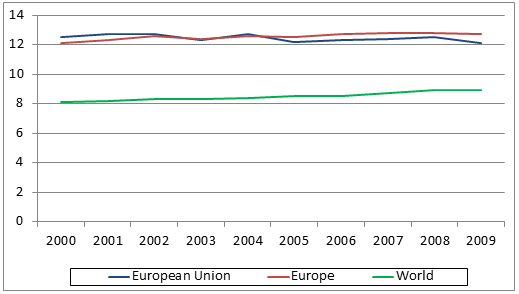



GLOBAL POULTRY TRENDS: Static Egg Consumption in Europe
With little growth in the human population and egg consumption generally flat, there is little chance of significant growth in overall European egg consumption, writes industry analyst, Terry Evans.Egg consumption per person in Europe is, at best, static in contrast to a steady increase in the global average (Table 1 and Figure 1), which rose steadily between 2000 and 2009 from 8.1kg to 8.9kg. Although average uptake in Europe at the start of the past decade was 50 per cent above the world level as it climbed from 12.1kg to 12.8kg between 2000 and 2007, it has since stagnated and in 2009 was just 43 per cent higher. Since 2005, the average for the European Union has shifted from being above to below that for the whole of Europe.
Between now and 2020, Europe's human population is forecast to increase by just 3.3 million (0.5 per cent) so no great boost in demand can be anticipated from this development.
In developed economies, a major trend to emerge has been the growth in eggs consumed as egg products. For Europe, roughly 20 per cent of all eggs are eaten in some form of product although for those EU countries that provide a break-down of shell egg and egg product consumption, the proportion of product usage averages nearer 27 per cent. Unfortunately, in only a few instances has the rise in egg product uptake increased total egg consumption as, in most instances the switch to products has been at the expense in the usage of eggs in shell. Again, in developed economies, the impact of real income growth on egg demand is minimal.
Another factor which does little to help expand demand is that, in general, egg industries spend relatively little on promotion when compared with their competitors, particularly cereals and juices for breakfast. Differences in average consumption between countries in Europe are less marked than in other major regions of the world. Also, where uptake is say, less than 10kg per person and year, and where a rise in consumption might reasonably be envisaged, unfortunately - without exception - these are countries with small human populations, hence the total volume of any increase will be small. Although this means that, for Europe as a whole, no significant increase can be foreseen in total egg consumption, this observation does not hold true for all countries in the region.
Hardly any European Union member country has managed to record higher annual per-capita egg uptake than in 2000. The FAO published figure for the Netherlands in 2009 of just 7.5kg looks like a typing error as the correct figure is likely to be nearer 17.5kg. But, even so the Dutch figures are misleading as the estimate is based on the availability of all hen eggs including hatching eggs.

Outside the EU, the most dramatic increase in egg consumption has taken place in Ukraine, where the estimate of supplies available to be eaten has risen from 9.5kg in 2000 to 15.6kg in 2009.
An expansion has also been recorded in the Russian Federation, the average rising from 12.7kg to 14.6kg. Although the human population there has contracted since 2000 and looks likely to continue to do so, the forecast for 2030 still points to around 137 million, which compares with 147 million in 2000.
More recent data on egg consumption has been gathered by the International Egg Commission (IEC) and published in its Annual Review. According to this IEC data egg consumption in France in 2011 averaged 222 eggs per person, of which, 135 were consumed as shell eggs and 87 (39 per cent) in egg products.
In Germany, uptake is considered to have slipped from 214 in 2010 to 212 in 2011. Just over 62 per cent of household purchases were barn eggs, 24 per cent came from free-range units, nine per cent were organic and a little over four per cent were from colony cages.
In Italy, the number eaten contracted between 2010 and 2011 from 210 to 206/person of which some 71 (35 per cent) were consumed in products.
According to the IEC country reports, egg consumption in the Netherlands increased between 2010 and 2011 from 185 to 188 eggs per person, equivalent to around 11.6 to 11.8kg. Some 23 per cent were eaten as products.
For Spain in 2011, it is estimated that almost 105 eggs (45 per cent) were consumed as products out of a total of almost 233.
In 2010, Poland's average was 200 per capita, while in Russia, where consumers consider that the egg price is far more important than the system of production, the 2011 average was 260 per person.
Price is also a big factor influencing egg demand in Ukraine, where earnings are low compared to most other European countries and where household expenditure on food accounts for around 48 per cent of income. Nevertheless, egg uptake is booming having risen from 282 per person in 2010 to 305 in 2011.
A positive promotional campaign in the UK boosted retail egg sales by almost four per cent in 2011 as total egg consumption in shell went up from 138 to 146. However, the quantity eaten as product was estimated to have slipped a shade from 44 to 43 eggs (23 per cent) as total usage climbed from 182 to 189 eggs per person and year.
April 2013









